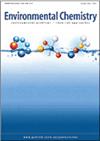凡纳滨对虾养殖周期微量元素含量评价
IF 2.3
4区 环境科学与生态学
Q3 CHEMISTRY, ANALYTICAL
引用次数: 1
摘要
集约化水产养殖是渔业产品的主要来源。因此,有必要调查这些产品的食品安全以及农场对红树林的环境影响。对虾的生产周期进行了评价,重点研究了虾和出水中微量元素的积累。结果揭示了最终产品中元素的安全水平;然而,养殖场产生的废水是红树林环境污染的重要来源。由于对海产品消费的高需求,水产养殖系统在过去几年中有所增加,这可能影响环境并使渔业受到有毒元素积累的影响。为了了解虾类食品安全和环境影响的一些参数,本研究评估了虾类整个生产周期中微量元素(Al、As、Cd、Co、Cr、Cu、Mn、Mo、Pb、Se、V和Zn)的浓度。方法采用电感耦合等离子体串联质谱法(ICP-MS/MS)和微波诱导等离子体光学发射光谱法(MIP-OES)测定巴西某虾场每周期约50只虾的微量元素含量。结果在他们最后的生命周期阶段,虾样品呈现出内容(mg克−1)跟随趋势的元素:铜(102±12)> Al(20.06±4.24)>锌(14.82±2.46)>锰(6.24±0.94)>(2.65±0.42)> Se(0.932±0.140)>有限公司(0.380±0.05)>莫(0.254±0.03)> V(0.204±0.02)。在巴西和美国的甲壳类动物中,镉和铅的含量是允许的,但在虾的生长的各个阶段,砷的含量比指南允许的含量高3 - 4倍。虾池最终流入红树林的污水显示出锌和锰的高质量分数,这可能是污染源。对虾样品中as - se、Se-Co、Se-V等元素存在一定的相关性。本研究是研究对虾整个养殖周期中微量元素含量的范围实验,鼓励研究者进行更广泛的调查,以评估养殖对虾对环境的影响。本文章由计算机程序翻译,如有差异,请以英文原文为准。
Assessment of trace element content throughout the white shrimp (Litopenaeus vannamei) farming cycle
Environmental context Intensive aquaculture is the main source of fisheries products. Thus, investigating the food safety of these products and the environmental impacts of the farms on mangroves is necessary. A shrimp productive cycle was evaluated with a focus on trace element accumulation in shrimps and effluent. The results revealed secure levels of elements in the final product; however, the effluent produced in farms is an important source of contamination to mangrove environment. Rationale Aquaculture systems have increased in the last years due to the high demand for seafood consumption, this could impact the environment and subject fisheries to accumulation of toxic elements. To understand some parameters of food safety and environmental impact, the present study evaluated the concentration of trace elements (Al, As, Cd, Co, Cr, Cu, Mn, Mo, Pb, Se, V and Zn) throughout the production cycle of shrimp. Methodology About 50 shrimps per cycle were collected in a shrimp farm in Brazil and their trace element contents were determined by inductively coupled plasma–tandem mass spectrometry (ICP-MS/MS) and microwave-induced plasma–optical emission spectroscopy (MIP-OES). Results At their final lifecycle stage, shrimp samples present a content (mg g−1) of elements following the trend: Cu (102 ± 12) > Al (20.06 ± 4.24) > Zn (14.82 ± 2.46) > Mn (6.24 ± 0.94) > As (2.65 ± 0.42) > Se (0.932 ± 0.140) > Co (0.380 ± 0.05) > Mo (0.254 ± 0.03) > V (0.204 ± 0.02). Discussion The content of Cd and Pb are in allowance with Brazil and USA legislation for crustaceans, however, the content of As is 3–4-fold higher than that allowed by guidelines in all stages of the growth of the shrimp. The final effluent of the shrimp’s pond into the mangroves shows a high mass fraction of Zn and Mn that could be a source of contamination. Some correlations between some elements in the shrimp samples were found, such as As–Se, Se–Co and Se–V. This study was a scoping experiment to study the content of trace elements throughout the farming cycle of shrimps, encouraging the researcher to undergo a wide survey to evaluate the environmental impact of aquaculture shrimp farming.
求助全文
通过发布文献求助,成功后即可免费获取论文全文。
去求助
来源期刊

Environmental Chemistry
环境科学-分析化学
CiteScore
4.50
自引率
0.00%
发文量
0
审稿时长
2.7 months
期刊介绍:
Environmental Chemistry publishes manuscripts addressing the chemistry of the environment (air, water, earth, and biota), including the behaviour and impacts of contaminants and other anthropogenic disturbances. The scope encompasses atmospheric chemistry, geochemistry and biogeochemistry, climate change, marine and freshwater chemistry, polar chemistry, fire chemistry, soil and sediment chemistry, and chemical aspects of ecotoxicology. Papers that take an interdisciplinary approach, while advancing our understanding of the linkages between chemistry and physical or biological processes, are particularly encouraged.
While focusing on the publication of important original research and timely reviews, the journal also publishes essays and opinion pieces on issues of importance to environmental scientists, such as policy and funding.
Papers should be written in a style that is accessible to those outside the field, as the readership will include - in addition to chemists - biologists, toxicologists, soil scientists, and workers from government and industrial institutions. All manuscripts are rigorously peer-reviewed and professionally copy-edited.
Environmental Chemistry is published with the endorsement of the Commonwealth Scientific and Industrial Research Organisation (CSIRO) and the Australian Academy of Science.
 求助内容:
求助内容: 应助结果提醒方式:
应助结果提醒方式:


